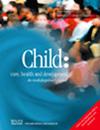Investigating Developmental Status of Children Aged 0–5 Years and Its Association With Child Gender, Family Background and Geographic Locations in Australian Community-Based Early Learning Centres
Abstract
Background
Early childhood plays a vital role in long-term outcomes such as health, learning, behaviour and wellbeing. Evidence shows that developmental screening of children aged 0–5 years is currently inadequate and understanding of key factors influencing child development in the years before school remain limited. This study aimed to examine the associations between a child's age, gender, family background, remoteness of residence, community socio-economic level and developmental status.
Methods
This study analysed data from a Paediatric Nurse Practitioners and Registered Nurses-led initiative, which offered Child Health Development Checks and referral support, for children attending Australian early learning centres from August 2022 to August 2023. The Brigance Screen III packages were used to do the child development screening, which assessed three domains for children aged 0–2 and five domains for those aged 2–5. Data from 1002 children (convenience sampling with children who attended the early learning centres) were included; univariable and multivariable logistic regression models and chi-square tests were performed.
Results
After controlling for other explanatory variables, children aged 2–3, were approximately six times more likely to have developmental concerns in language and self-help domains (p < 0.05, p < 0.001), when compared to children aged 5. Boys were around twice as likely to have developmental concern in academic and self-help domains (p < 0.01). Children from culturally and linguistically diverse backgrounds were approximately two to three times more likely to have developmental concerns in language and social–emotional domains (p < 0.01, p < 0.001). Children living in mid-level socio-economic communities were more than twice as likely to have developmental concerns in academic domains, when compared to children living in most advantaged areas (p < 0.05).
Conclusions
This study suggests that male children, those from culturally and linguistically diverse backgrounds, or children from mid-level socio-economic communities may be at higher risk of experiencing developmental concerns.

 求助内容:
求助内容: 应助结果提醒方式:
应助结果提醒方式:


